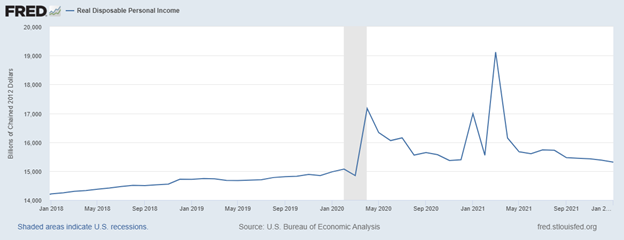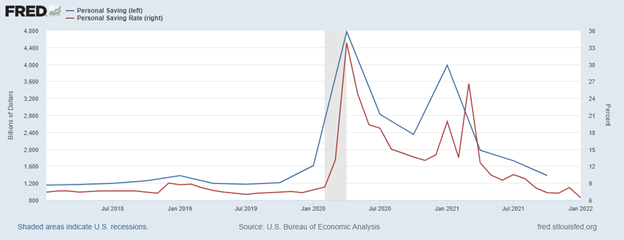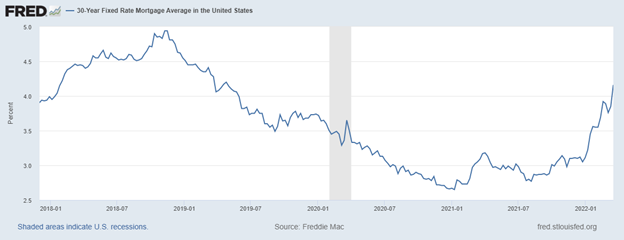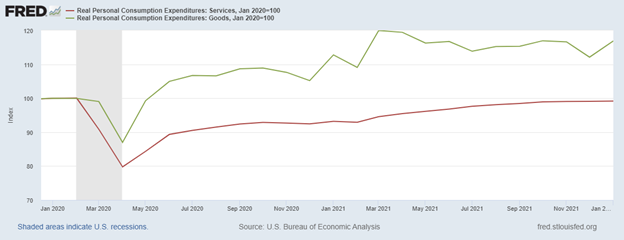March Market Update

Headwinds continue to mount against consumer demand
Lately it feels as though the market is thrown another curveball on a near daily basis. In January's market update, we discussed our outlook for inflation through 2023. The final paragraph of that update stated, “it is possible that [our inflation expectations] will be too optimistic” and that, unfortunately, appears to be the case. Russia’s invasion of Ukraine and the resulting economic sanctions have had global repercussions, adding to inflationary pressures and economic uncertainty. Last month's market update discussed some of the effects being felt by the market due to the increased level of uncertainty.
This month, we’ll take a look at some of the headwinds that could put downward pressure on consumer demand in the second half of 2022, many of which stem from the topics covered in our two previous market updates.
As inflation continues to surge, real disposable personal income has been struggling. It has declined 9 of the past 10 months and has fallen 20% from its high point in March 2021 (see Figure 1 below). It now sits at just 1.6% above its pre-pandemic level in January 2020. If inflation continues to persist, real disposable personal income could continue to decline as we head towards Q3. Additionally, personal savings are dwindling down. The personal saving rate has fallen to a near 10-year low of 6.4%, down from a high of 33.8% in April 2020. As a result, personal savings have fallen 71% from their high in Q2 2020. It is still 14% above its pre-pandemic level in Q4 2019 but may fall below this level in Q1 2022 (see Figure 2 below).
Figure 1

Figure 2

In an effort to combat inflation, the Fed raised the federal funds rate by 25 basis points at their March meeting and they’re expected to continue to raise rates at each of their six remaining meetings in 2022. The market initially anticipated increases of 25 basis points at each meeting, but as inflation has persisted at the highest levels in 40 years, Jerome Powell, Chair of the Board of Governors of the Federal Reserve System, has taken a more aggressive stance on inflation. This has led some analysts to expect rate increases of 50 basis points at the next two meetings, which would be the first 50 basis point increases since 2000. As the Fed raises the federal funds rate, interest rates will subsequently increase which will, in theory, slow spending and lower inflation. The effects of increasing rates are already starting to be felt in the housing market as 30-year mortgage rates have increased to their highest level since April 2019 (see Figure 3 below), leading many economists to lower their forecasts for 2022 home sales.
Figure 3

All of these headwinds could have a negative effect on overall consumer spending as we move into the second half of 2022. The freight market, however, may be facing an additional headwind: how consumers allocate their spending between goods and services. Spending on goods has a much more significant effect on freight demand than spending on services, and spending on goods has been elevated for the past two years as a result of the pandemic’s effects on consumer spending habits. Compared to January 2020 levels, real personal consumption expenditures on goods have increased 16.9% while real expenditures on services are still 0.8% below their January 2020 levels (see Figure 4 below). If Covid-19 cases continue to fall, we could see a significant shift in spending habits in favor of services as summer vacation trips begin and people become more comfortable with traveling. This shift in spending habits would pull demand away from the freight industry in addition to the overall decrease in spending expected as the year progresses.
Figure 4

These are only a few of the possibilities as we continue through 2022. There is an incredible amount of uncertainty in the market that makes it difficult to predict what will happen next. Whatever the outcome, ArcBest has a solution to fit any need. As a logistics company with owned assets, we’re able to offer solutions through ABF Freight® and our Panther Premium Logistics® fleet in addition to our network of more than 80,000 capacity providers. With a combination of advanced supply chain technology and an experienced customer solutions team, ArcBest is equipped to find ways to solve even the toughest logistics problems.

